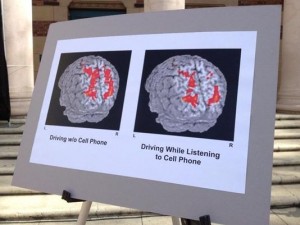One of the more uncomfortable situations to be in is after you have introduced yourself to a person and discover he or she has been in your class all semester. How is it possible that this happens, especially in small class sizes like at the University of Richmond? Are you just self-absorbed, or is there a bigger reason?
Luckily, you are not self-absorbed, you were just paying attention to the teacher! Inattentional blindness describes the phenomenon in which a person fails to be aware of a visual stimulus because attention is directed away from it. Therefore, if you’re focusing on the professor, you’re less likely to notice other people in the room. Even though you take the occasional sweeping glance of the classroom, not much is registered because your attention is on the lecture.

Both the temporal and parietal lobes are associated with attention. https://www.udellgroup.com/wp-content/uploads/2015/06/brain1.jpg
So what is the reason for inattentional blindness? Based on the name alone, one might assume there is a defect in the visual systems, but that is not true. Inattentional blindness is due to limitations of our attentional systems and is also considered a defect in visual awareness. Visual awareness refers to being attentive to things in our visual field, and its neural pathway has been studied many times. Research shows visual awareness is associated with the ventral visual pathway from V1 to the temporal cortex, as well as activation of frontal and parietal areas, which are associated with attention. One study suggests that the interaction between ventral areas and fronto-parietal areas is needed for visual awareness to occur. However, there are limitations to this theory, as awareness is very difficult to officially define and breaks down into several different ideas (Koivisto, Kainulainen, & Revonuso, 2011).
Test Yourself
Supposedly the most phenomenal part of Inattentional blindness is how easily it happens. The most famous study, done by Daniel Simons and Christopher Chabris in 1999, is best explained by action. You can try this test below.
Did you spot the gorilla? Probably not.
So, how does inattentional blindness affect our daily lives? One of the most common activities inattentional blindness occurs during is while driving. Driving requires you to select objects and driving skills to focus on, so people often miss things. This worsens when drivers talk on cell phones, because they pay attention to their conversation and not what is happening on the road. Drivers talking on cell phones have a greater risk of not noticing a car braking in front of them, or see traffic signals (Jensen, Yao, Simons, & Street, 2011). Another major issue on the road is bikers; drivers focusing on road signs or other cars often don’t see a biker sharing the road. One public service announcement creatively addresses this problem, with another attention test.
https://www.youtube.com/watch?v=ubNF9QNEQLA
If inattentional blindness happens so often, how do we overcome it, especially in situations where not being aware of visual stimuli could result in injury or death, like in driving? Reducing the amount of things you are attending to helps, i.e. no calling or texting while driving. Just look at the differences of activation in the areas important for attention while driving with a cell phone versus driving distraction free! A focused sweep of the visual field will help you remember what is around you, so you may be able to see a car about to pull in front of you before it takes you by surprise. Always remain alert, and be careful!
References:
Koivisto, M., Kainulainen, P., & Revonsuo, A. (2009). Neuropsychologia: The relationship between awareness and attention: Evidence from ERP responsesElsevier. doi:10.1016/j.neuropsychologia.2009.06.016
Jensen, Melinda S., Richard Yao, Whitney N. Street, and Daniel J. Simons. “Change Blindness and Inattentional Blindness.” Wiley Interdisciplinary Reviews: Cognitive Science WIREs Cogn Sci 2.5 (2011): 529-46. Web. 9 Oct. 2015.
Chabris, Christopher F., and Daniel J. Simons. The Invisible Gorilla: And Other Ways Our Intuitions Deceive Us. New York: Crown, 2010. Print.
https://www.youtube.com/watch?v=vJG698U2Mv
GOOGLE DOC:
https://docs.google.com/a/richmond.edu/document/d/1lh6myji7NkzWCcvgZrrCGVf9npT6Ly4VmJwyJgXYCuc/edit?usp=sharing

